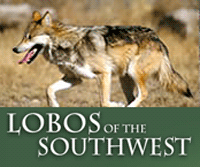Mexican Wolf Recovery
The Mexican gray wolf (Canis lupus baileyi) is the most genetically distinct subspecies of gray wolf in North America, as well as the smallest in size. A typical Mexican wolf is about 4.5- 5.5 feet long, from snout to tail, weighs from 50 to 80 pounds, and has a coat with a mix of buff, gray, red and black. Like all wolves, the Mexican wolf communicates using body language, scent marking and vocalization. The main prey for Mexican wolves is elk making up 74% of their diet. Other prey species include white-tailed deer, mule deer, javelina, jack rabbit, cottontail rabbits and smaller mammals.
Commonly called "lobo", the Mexican gray wolf has all but disappeared from its historic range in the southwestern United States and throughout Mexico. Predatory controls from the late 1800s to the mid-1900s made it the rarest gray wolf in North America. By the late 1970s, the Mexican gray wolf had virtually disappeared in the southwestern United States. It was listed as endangered on the federal endangered species list in 1976. An initial recovery objective of a wild population of at least 100 wolves over 5,000 miles of its historical range were approved by the U.S. Fish and Wildlife Service (USFWS) and the Direccion General de la Fauna Silvestre in Mexico in a 1982 recovery plan. The International Union for Conservation of Nature (IUCN) considers Mexican wolf recovery the highest priority for wolf conservation worldwide.
In 1997, a plan was approved calling for the reintroduction of Mexican wolves in Arizona and New Mexico. In March 1998, 11 Mexican gray wolves in three family groups were released into the wilds of the Apache National Forest of southeastern Arizona. Two additional wolves were released later that year. The highlight of the recovery program took place in 1998 when, for the first time in 50 years, a Mexican gray wolf pup was born in the wild.
Illegal shooting still remains the number one killer of wolves along the Arizona-New Mexico border having claimed at least 105 wolves from 1998 - 2019. The US Fish & Wildlife Service revised the rules in January 2015 to allow for broader roaming privileges letting the wolves roam outside of the current Blue Range Wolf Recovery Area, which is considered too limited by scientists. This would allow wolves to naturally disperse into other places with suitable habitat throughout the southwest, but they will impose an artificial, and politically-based boundary at Interstate I-40. Wolves are still prohibited from establishing territories in the Grand Canyon region. Conservationists and some ranchers agree that the human-wolf conflict could be eased if wolves weren't so concentrated.
Wolf recovery requires both captive breeding and reintroduction to the wild. Captive management is necessary to increase the population and to minimize the potential for in breeding depression. Reintroduction is essential to ensure that Mexican wolves exist in the wild and persist as more than just a population of zoo wolves. The first captive-reared Mexican wolves were reintroduced into the Blue Range Wolf Recovery Area beginning in January 1998. Immediately prior to reintroduction, no wild Mexican wolves were thought to remain in the U.S. or Mexico.
Currently, there are about 196 Mexican wolves roaming free in the wild in the U.S. There are also currently about 380 wolves at 60 captive breeding facilities throughout the United States and Mexico.
To read more about the feasibility of wolves in the Grand Canyon Ecoregion, visit this page.
BIBLIOGRAPHY
U.S. Fish & Wildlife Service's Mexican Gray Wolf Recovery Program
Brown, Wendy. El Lobo Returns. International Wolf; 1998. 8(4): 3-7.
United States Fish and Wildlife Service. Mexican Wolf Recovery Program: Natural History and Recovery Fact Sheet. 1997.
United States Fish and Wildlife Service. Mexican Wolf Recovery Program: Answers to Frequently Asked Questions about the Reintroduction of Mexican Wolves in the Southwest. 1997.
Wildlife Committee of the Rio Grande Chapter of the Sierra Club and the Mexican Wolf Coalition. The Mexican Wolf. Albuquerque, NM: Sierra Club; 1993.
(Most of the information above is from The International Wolf Center website www.wolf.org)





